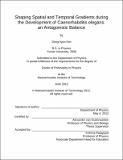Shaping spatial and temporal gradients during the development of Caenorhabditis elegans : an antagonistic balance
Author(s)
Kim, Dong hyun, Ph. D. Massachusetts Institute of Technology
DownloadFull printable version (6.818Mb)
Other Contributors
Massachusetts Institute of Technology. Dept. of Physics.
Advisor
Alexander van Oudenaarden.
Terms of use
Metadata
Show full item recordAbstract
How the tissues of a developing organism are reproducibly patterned has been a major question in biology. Under adequate conditions, a single fertilized cell can generate a full variety of mature cell types and organize them into a developed organism. In order to accomplish these complex tasks of self-organization, positional and temporal information must be provided to individual cells to ensure that the right developmental events occur at appropriate times. This is at least partially assisted by the specification of spatial and temporal axes formed and maintained during development. One way to define position and time within a developing organism is to form spatial or temporal gradients of signaling molecules, which patterns tissues in a concentration-dependent manner. A critical challenge of such gradient based patterning mechanisms is to maintain the desired gradient profiles of signaling molecules in a heterogeneous and fluctuating cellular environment. In this thesis, I describe how spatial and temporal gradients of signaling molecules can be refined and maintained during development of the model organism Caenorhabditis elegans. Using quantitative measurement techniques and analyses, I find that such tasks can be achieved by the balance between the activities of gradient forming signaling molecules and their antagonistic counterparts.
Description
Thesis (Ph. D.)--Massachusetts Institute of Technology, Dept. of Physics, 2012. Cataloged from PDF version of thesis. Includes bibliographical references (p. 131-141).
Date issued
2012Department
Massachusetts Institute of Technology. Department of PhysicsPublisher
Massachusetts Institute of Technology
Keywords
Physics.